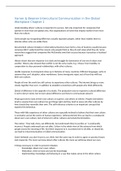Varner & Beamer Intercultural Communication in the Global
Workplace Chapter 1
Understanding others’ cultures is important to success. Not only important for companies that
operate in more than one global area. Also organizatons at home that employ workers from more
than one culture.
Some people say recognizing diference actually separates people, rather than enables them to
tolerate others who are unlike them.
Documented cultural mistakes in internatonal business have led to a loss of business usually because
someone didn’t understand the reasons why people think as they do and value what they do. Some
researchers suggest that companies like McDonalds owe their success because it practces a localized
approach.
History shows that one response is to clash and struggle for dominance of one set of values over
another. History also showed that confict is not the only results. E.g.: Moses: from hostlity, to
cooperaton to close personal relatonships, with other cultures.
Hostle responses to immigrants show up in histories of many countries. Diferent languages, write in
systems they can’t decipher, other worldviews. Some immigrants reject out of fear they will lose
their own culture.
People all over the world are stll curious to experience other cultures. The internet brings us more
closely together than ever. In additon to establish connectons with people who think diferently.
Denial of diference is the opposite of curiosity. The productve way to respond to cultural diference
is not to deny it exists, but to learn about diference and how to communicate about it.
All groups tend to look at their own culture as superior, and others as inferior. People everywhere
tend to assume their own culture has got things right and they tend to assess all other cultures by
how closely they resemble their own. The self-reference criterion is an important concept that
explains this behaviour.
Those with litle experience of other cultures are especially inclined to believe that their own culture
is normatve and at the centre of human experience. (ethnocentrism) this can lead to a complacent
about one’s own culture, lack of interest in other cultures and actual discriminaton.
The noton: ‘‘they talk, dress, eat diferently, but underneath they’re just like us’’ is profoundly
incorrect. People underneath are not alike. Culture is the whole view of the universe from which
people assess the meaning of life. And their response to it, to pretend we’re all alike, or should be,
can lead to miscommunicaton or failed communicaton.
Geert Hofstede: you don’t have to act, think, feel the same way in order to agree on practcal issues
and cooperate. The more we know about other cultures the more we will know about our own.
3 things necessary in order to prevent mistakes:
- Knowledge: about one’s own culture
- Motvaton: drive to know and use the knowledge
- Implementng: knowledge and behaving in a way that makes sense in the other culture.
, Culture is the coherent, learned, shared view of a group of people about life’s concerns, expressed in
symbols and actvites, that ranks what is important, furnishes attudes about what things are
appropriate, and dictates behaviour.
Culture is coherent: regardless of how peculiar a fragment of a culture seems, when it is placed
within the whole tapestry of the culture, it makes sense. E.g.: el dia de los muertos – China
Culture is learned: process begins immediately afer birth. Means it’s also learnable.
Culture view of group: agree without having to talk about it.
Culture ranks importance: values or priorites
Culture furnishes attudes: learned tendencies to respond to phenomena in a consistent way.
Attudes are based on beliefs and values.
Culture dictates how to behave: behaviour comes directly from attudes.
e.g.: relatonship: value – honesty, attude – telling lies is bad, behaviour – lying.
Onstage culture: behaviour we display. E.g.: shaking hands, celebratng birthdays
Backstage culture: values. Not so visible.
Transactonal culture exists when interactons to cultural cues and modify own behaviour, creatng
new temporary culture.
Culture shock 4 stages:
- Euphoria: everything excitng
- Disillusionment and frustraton
- Adjustment
- Integraton
Reverse culture shock: when returning home.
Prejudice: generalizatons based on limited knowledge, and that express an evaluaton – usually
negatve.
Racism: form of prejudice that leads to behaviour that excludes or side-lines people on the basis of
their perceived race. – sexism, ageism
Bias: bias for something: preference – bias against something: negatve.
Discriminaton: when biases or prejudices are acted on.
Cultural intelligence: the capacity of an individual to learn and understand another culture and then
act accordingly. (CQ)
CQ: 3 components: cogniton (knowledge, motvaton (adapt), behaviour (acton)
Popular culture like music, food, cars constantly change. E.g.: it has altered the way space and tme
afect human communicaton.
Culture and communicaton are ofen connected: culture is learned and shared through
communicaton, and communicaton is based on cultural norms.
Cross-cultural communicaton: involves comparison
Intercultural communicaton: when 2 or more cultures interact






